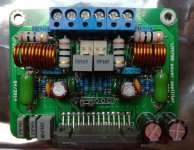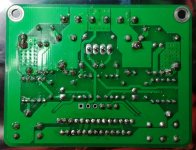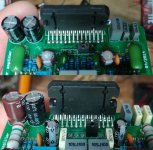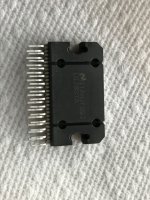Hi!
I used for 3 years two LM4780 kit (stereo 2x LM3886 chip) with Connex' SMPS300RE 2x32V successfully, in an 3 way active system (home made MiniDSP 2x8 HD). This amp driving treble & medium part.
I planed to modify my system to add some power, because of my children' party
So I have built only one LM4780 amp for trebles (over 3kHz) with same SMPS power supply, and two Hypex UcD180ST for medium amp.
I own 5 LM4780 PCB (I bought it on Ebay). During several test out of the box, 3 of them where shutting down: all presenting discontinue voltage in final stage (ex. 13V for 18V linear power).
I have changed one LM4780 chip but no way!
Any idea to test and fix this?
Two potential errors:
1. micro short circuit because of metal dust (I have a little space to work)
2. some test has been made with SMPS240QR 2x45V, which is the chip upper limit (no signal)
PS : all few components around are 50V (electrolytic capacitor) to 100V.
I used for 3 years two LM4780 kit (stereo 2x LM3886 chip) with Connex' SMPS300RE 2x32V successfully, in an 3 way active system (home made MiniDSP 2x8 HD). This amp driving treble & medium part.
I planed to modify my system to add some power, because of my children' party
So I have built only one LM4780 amp for trebles (over 3kHz) with same SMPS power supply, and two Hypex UcD180ST for medium amp.
I own 5 LM4780 PCB (I bought it on Ebay). During several test out of the box, 3 of them where shutting down: all presenting discontinue voltage in final stage (ex. 13V for 18V linear power).
I have changed one LM4780 chip but no way!
Any idea to test and fix this?
Two potential errors:
1. micro short circuit because of metal dust (I have a little space to work)
2. some test has been made with SMPS240QR 2x45V, which is the chip upper limit (no signal)
PS : all few components around are 50V (electrolytic capacitor) to 100V.
I would suggest you to post pics to let others see the circuits you are talking about. As for the wild guess of what can be the problem in order from higher to lower probability:
- ebay assembled amps aren't populated with the original LM4780 (these are mostly fakes these days)
- the high supply voltage killed the chips. Note the highest supply voltage of the LM4780 with and without input signal present.
- combination of the two above factors: fake LM4780s did not survive the elevated supply voltage.
- all other possibilities involving wrong connections, bad assembly, cold joints etc.
Regards,
Oleg
- ebay assembled amps aren't populated with the original LM4780 (these are mostly fakes these days)
- the high supply voltage killed the chips. Note the highest supply voltage of the LM4780 with and without input signal present.
- combination of the two above factors: fake LM4780s did not survive the elevated supply voltage.
- all other possibilities involving wrong connections, bad assembly, cold joints etc.
Regards,
Oleg
I would suggest you to post pics to let others see the circuits you are talking about.
Thanks for your reply.
Here is photo. It's a double sided PCB. I think a good work.
ebay assembled amps aren't populated with the original LM4780 (these are mostly fakes these days)
I bought 17,5€ to a Czech guy 3 years ago.
It was perfect since I change my plan and power it too much, probably?
I do not see other component which could be damaged.
Attachments
probably.the chips themselves are almost certainly fake if they came from eBay.
Report your faults through feedback.
If you are sure they are non genuine, then also report them for "Fraud"
@asuslover: see picture below. On top the damaged one, IC changed (from Ebay) without success. Below the original one, in perfect condition, working.
ICs are National Semiconductor (not very visible here).
@tomchr: yes heat sink attached, isolated from ground because of -V
I noted it was necessary to use nylon screw or metal with thermal sheath: the metal sole isn't far from screw aperture.
@OlegSh: that's my conclusion because of overload power... or fragile fake chip. But almost 3 years function for 3 of them, it's strange.
ICs are National Semiconductor (not very visible here).
@tomchr: yes heat sink attached, isolated from ground because of -V
I noted it was necessary to use nylon screw or metal with thermal sheath: the metal sole isn't far from screw aperture.
@OlegSh: that's my conclusion because of overload power... or fragile fake chip. But almost 3 years function for 3 of them, it's strange.
Attachments
@tomchr: yes heat sink attached, isolated from ground because of -V
I noted it was necessary to use nylon screw or metal with thermal sheath: the metal sole isn't far from screw aperture.
Yeah... The LM4780 is not the easiest to work with for those reasons.
But almost 3 years function for 3 of them, it's strange.
With a nylon screw, the LM4780 could have overheated as the screw stretched. I would have expected that to result in the chip shutting down safely and the sound quality to suffer dramatically as the SPiKe protection would kick in often. I wouldn't expect the chip to break.
The boards look like two-channel boards. Are both channels dead on all boards?
Do you have a power supply that can provide a lower voltage? ±15 or ±20 V would be ideal. Hook the boards to ±15 V. No heat sink necessary. Don't connect a load. Run a 400 Hz sine wave (create one at Professional Online Audio Frequency Signal Generator) into the input of the amp at, say, 100 mV RMS amplitude. Measure the output voltage. It should be around 2 V RMS, assuming a gain of 26 dB.
If this test fails, measure the DC voltage on pin 14 and pin 20 (the two MUTE pins). You should have -2.8 to -3.0 V here. If this voltage is closer to 0 V or positive, the chip is muted.
Tom
Hi!
It's difficult to take a picture of the chip on board. I can see the NS logo and same reference as "asuslover" posted.
After many test, the conclusion is the ICs destruction. I suppose because of over voltage from my SMPS 2x45V, on load.
@AndriyOL: the crossover was not connected (a "free air" test). Metal screw yes but after a perfect straight heat sink drilling.
Thanks all for your support
It's difficult to take a picture of the chip on board. I can see the NS logo and same reference as "asuslover" posted.
After many test, the conclusion is the ICs destruction. I suppose because of over voltage from my SMPS 2x45V, on load.
@AndriyOL: the crossover was not connected (a "free air" test). Metal screw yes but after a perfect straight heat sink drilling.
Thanks all for your support
After many test, the conclusion is the ICs destruction. I suppose because of over voltage from my SMPS 2x45V, on load.
Yeah... Operating the chip beyond its absolute maximum supply voltage rating is a known cause of death.
Thanks all for your support
You're welcome.
Tom
Yeah... Operating the chip beyond its absolute maximum supply voltage rating is a known cause of death.
Fortunately, I made these tests with just 3 PCBs.
Regarding the genuine part or not, what is the real consequences of fake IC?
There are several common types of counterfeit chips (see other threads on this forum):
- legitimate units that have been stolen from the distribution channel and re-sold
- units that are of legitimate construction - genuine die and assembly from the legitimate manufacturer (in this case NS / TI) - but are test rejects that have some how been 'liberated' from the factory.
- the units might start with rejected die from the manufacturing flow that have been assembled into a package at a counterfeiter's factory
- units that appear to be in the correct package and (almost) correct marking that contain IC die that are not the right die. This is especially common in more mainstream devices -- for example most any generic op-amp might be remarked as a higher price/performance device and passed off as such.
I've seen all of these. In the case of LM3886, the last type of counterfeit is less likely as the die is a relatively unique design with not-so-common package and pinout. It's one thing to pass off a very cheap, 'bubble gum' op-amp as an OPA627. It's another thing passing off a low-power amp chip as an LM3886 -- the counterfeit die tend to blow up.
The 'real consequence' ?? At the minimum the IC may not be performing to spec. What if the specified 0.0x% distortion is really x.0% ? Whether this is minor or gross likely cannot be determined without test equipment capable of measuring product specification. Reliability is likely much lower -- maybe your chip will blow up on the first power-up, maybe not until a year later. And, you are supporting criminal activity by buying/using counterfeits.
Personally, I would hate to spend my valuable time, effort, and money on a DIY project and then potentially compromise it by trying to 'cheap out' on the purchase of chips that are of unknown origin. The point of my DIY project is to build something of quality that I can be proud of -- buying key components from questionable/suspect sources does not contribute to that goal.
- legitimate units that have been stolen from the distribution channel and re-sold
- units that are of legitimate construction - genuine die and assembly from the legitimate manufacturer (in this case NS / TI) - but are test rejects that have some how been 'liberated' from the factory.
- the units might start with rejected die from the manufacturing flow that have been assembled into a package at a counterfeiter's factory
- units that appear to be in the correct package and (almost) correct marking that contain IC die that are not the right die. This is especially common in more mainstream devices -- for example most any generic op-amp might be remarked as a higher price/performance device and passed off as such.
I've seen all of these. In the case of LM3886, the last type of counterfeit is less likely as the die is a relatively unique design with not-so-common package and pinout. It's one thing to pass off a very cheap, 'bubble gum' op-amp as an OPA627. It's another thing passing off a low-power amp chip as an LM3886 -- the counterfeit die tend to blow up.
The 'real consequence' ?? At the minimum the IC may not be performing to spec. What if the specified 0.0x% distortion is really x.0% ? Whether this is minor or gross likely cannot be determined without test equipment capable of measuring product specification. Reliability is likely much lower -- maybe your chip will blow up on the first power-up, maybe not until a year later. And, you are supporting criminal activity by buying/using counterfeits.
Personally, I would hate to spend my valuable time, effort, and money on a DIY project and then potentially compromise it by trying to 'cheap out' on the purchase of chips that are of unknown origin. The point of my DIY project is to build something of quality that I can be proud of -- buying key components from questionable/suspect sources does not contribute to that goal.
And, you are supporting criminal activity by buying/using counterfeits.
Note my question was technical, not political
About this point I agree and knows I had never considering a chip like LM4780 could be a fake.
But how to recognize genuine chip from counterfeits? (without huge measuring hardware)
you don't.
you get it from a respectible vendor, or better, the maker of the chip.
everyting else is lottery.
you can only test the chips if they stand true to the datasheet specifications, using far too expensive equipment to make it worth. and that alone does not mean its the real thing, it can allso be an eqvivalent fake chip.
support the developers and makers of the chips, buy directly from them.
you get it from a respectible vendor, or better, the maker of the chip.
everyting else is lottery.
you can only test the chips if they stand true to the datasheet specifications, using far too expensive equipment to make it worth. and that alone does not mean its the real thing, it can allso be an eqvivalent fake chip.
support the developers and makers of the chips, buy directly from them.
Note my question was technical, not political
Note that you received a technical answer.
Whether something is legal or not is not a political issue. It's a legal issue.
The best way to obtain genuine parts is to go through one of the manufacturer's distributors. In case of TI, that would be RS, Farnell, Newark, Digikey, Mouser.
Tom
- Status
- This old topic is closed. If you want to reopen this topic, contact a moderator using the "Report Post" button.
- Home
- Amplifiers
- Chip Amps
- LM4780 issue



